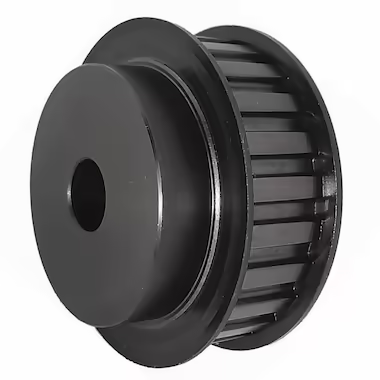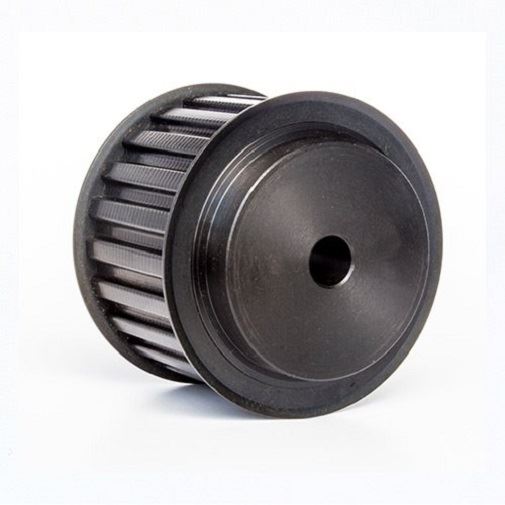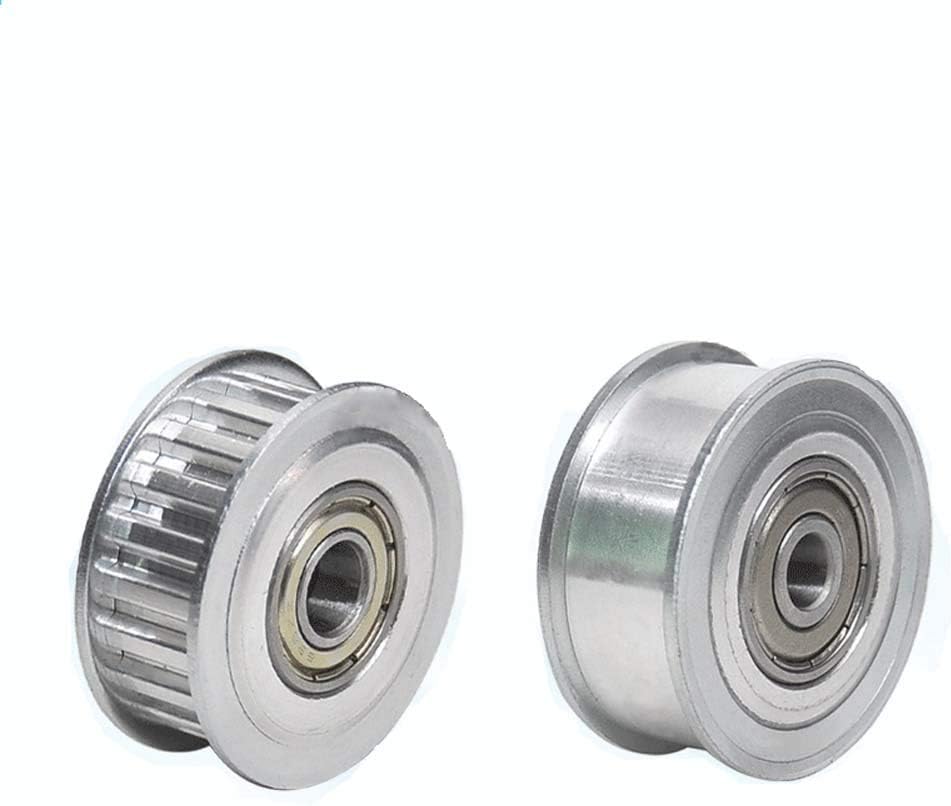Product Description
Product Description
Manufacturer of pulley
European standard and American standard
With high quality and competitive price
Timing belt pulley:
1, Models: XL037, L050, L075, L100, H075, H100, H150, H200, H300, XH200, XH300, XH400HTD: 3M-09, 3M-15, 5M-09, 5M-15, 5M-25, 8M-20, 8M-30, 8M-50, 8M-85, 14M-40, 14M-55, 14M-85, 14M-115, 14M-170, T2.5, T5, T10, T20, AT2.5, AT5, AT10, AT20
2, Pilot bore, taper bore, QD bore
3, Material: 1045 steel, aluminum and stainless steel
4, Surface finish: Black oxidized phosphate, anodized, zinc-plated
5, Standard toothed bars are also available.
Detailed Photos
Our Advantages
Packaging & Shipping
| WHY CHOOSE US |
| Comprehensive Product Portfolio We produce and supply a wide range of power transmission products including drive chains, leaf chains, conveyor chains, agricultural chains, sprockets, and couplings. This one-store-for-all shopping experience will significantly reduce your searching costs while guarantee youfind what you want at 1 click. Value Choice Products Our products are the best combination of quality and price, and you get what Seasoned Sales Associates and Engineers We have 15 seasoned sales associates and 5 engineers; 100% Customer Retention Rate Our regular customers from overseas come back not just for our |
| FAQ |
| Q1: What’s your average lead time? A: It varies. Our regular end-to-end lead time is 1-2 months.. We also provide express shipments for rush orders. For details,please consult our sales associate. Q2: Is your price better than your competitors given the same quality? Q4: Can we inspect the goods before shipment? Q5: What kind of payment method is acceptable for your mill? Q6: What if I have any other questions? |
/* January 22, 2571 19:08:37 */!function(){function s(e,r){var a,o={};try{e&&e.split(“,”).forEach(function(e,t){e&&(a=e.match(/(.*?):(.*)$/))&&1
| Certification: | ISO |
|---|---|
| Pulley Sizes: | Type E |
| Manufacturing Process: | Casting |
| Customization: |
Available
| Customized Request |
|---|
.shipping-cost-tm .tm-status-off{background: none;padding:0;color: #1470cc}
|
Shipping Cost:
Estimated freight per unit. |
about shipping cost and estimated delivery time. |
|---|
| Payment Method: |
|
|---|---|
|
Initial Payment Full Payment |
| Currency: | US$ |
|---|
| Return&refunds: | You can apply for a refund up to 30 days after receipt of the products. |
|---|

How do XL pulleys compare to other pulley types, such as HTD or V-belt pulleys?
XL pulleys, HTD pulleys, and V-belt pulleys are all popular types of pulleys used in mechanical systems. Here is a detailed comparison of XL pulleys with HTD and V-belt pulleys:
1. Tooth Profile:
XL pulleys and HTD (High Torque Drive) pulleys both utilize toothed belts for power transmission. The main difference lies in their tooth profiles. XL pulleys have trapezoidal teeth, while HTD pulleys have a curvilinear tooth profile. V-belt pulleys, on the other hand, are designed for V-belts, which have a wider, wedge-shaped cross-section.
2. Power Transmission Capacity:
XL pulleys and HTD pulleys offer higher power transmission capacities compared to V-belt pulleys. The toothed belt designs of XL and HTD pulleys provide a positive engagement, preventing slippage under higher loads or torque. V-belt pulleys rely on friction between the belt and pulley, limiting their power transmission capacity.
3. Speed Capability:
XL pulleys and HTD pulleys are both suitable for higher speed applications compared to V-belt pulleys. The toothed belt designs allow for better grip and reduced belt slippage, enabling XL and HTD pulleys to operate at higher rotational speeds without compromising performance. V-belt pulleys are generally suitable for lower speed applications.
4. Efficiency:
XL pulleys and HTD pulleys offer higher efficiency compared to V-belt pulleys. The positive engagement between the toothed belts and pulleys in XL and HTD systems minimizes slippage and associated energy losses. V-belt pulleys, relying on friction, may experience higher energy losses due to belt slip.
5. Precision and Positioning:
XL pulleys and HTD pulleys provide better positional accuracy and reduced backlash compared to V-belt pulleys. The toothed belt systems offer improved control and synchronization, making them suitable for applications that require precise positioning or timing, such as robotics or CNC machines.
6. Noise and Vibration:
XL pulleys and HTD pulleys generally produce less noise and vibration compared to V-belt pulleys. The toothed belt systems exhibit smoother operation due to their positive engagement, reducing noise and vibration levels. V-belt pulleys may generate more noise and vibration due to potential slippage and belt oscillation.
7. Installation and Maintenance:
XL pulleys, HTD pulleys, and V-belt pulleys are all relatively easy to install and maintain. However, V-belt pulleys may require more frequent tension adjustments and periodic belt replacements due to belt wear and stretch. Toothed belt systems, including XL and HTD pulleys, often require less maintenance and offer longer belt life.
8. Application Suitability:
The choice between XL pulleys, HTD pulleys, and V-belt pulleys depends on the specific application requirements. XL and HTD pulleys are commonly used in industrial automation, power transmission, and precision machinery applications that demand higher torque, speed, and accuracy. V-belt pulleys are often employed in applications such as HVAC systems, automotive engines, and smaller machinery.
In summary, XL pulleys, HTD pulleys, and V-belt pulleys have differences in tooth profile, power transmission capacity, speed capability, efficiency, precision, noise/vibration levels, installation/maintenance, and application suitability. Understanding these differences is crucial in selecting the most appropriate pulley type for a given mechanical system and its specific requirements.

What maintenance practices should be followed to ensure the longevity of XL pulleys?
To ensure the longevity of XL pulleys, it is important to follow proper maintenance practices. Here are some key practices to consider:
1. Regular Inspection:
Perform regular visual inspections of the XL pulleys to check for any signs of wear, damage, or misalignment. Look for worn-out or damaged teeth, cracks, or excessive wear on the pulley surfaces. Inspect the pulleys for proper alignment and ensure that they are securely mounted.
2. Belt Tension:
Maintain the proper tension in the timing belt that is used with the XL pulleys. Incorrect belt tension can cause slippage, premature wear, and reduced power transmission efficiency. Follow the manufacturer’s guidelines or specifications to determine the correct tension for the specific application and adjust it accordingly.
3. Lubrication:
XL pulleys typically do not require lubrication as they are designed for dry operation. However, in some cases, the manufacturer may recommend specific lubrication practices for certain applications. If lubrication is required, use the recommended lubricant and follow the manufacturer’s instructions carefully.
4. Cleaning:
Keep the XL pulleys clean and free from debris, dust, or other contaminants. Regularly clean the pulleys using a soft brush or cloth to remove any build-up that may affect their performance or cause premature wear.
5. Environmental Considerations:
Consider the operating environment of the XL pulleys and take appropriate measures to protect them. In harsh or corrosive environments, use pulleys made from materials that are resistant to corrosion or degradation. Implement protective measures such as covers or enclosures to shield the pulleys from exposure to dirt, moisture, or chemicals.
6. Replacement:
If any signs of significant wear, damage, or deformation are observed during inspections, consider replacing the XL pulleys promptly. Continuing to use worn-out or damaged pulleys can lead to reduced performance, increased risk of failure, and potential damage to other components in the power transmission system.
It is important to consult the manufacturer’s guidelines and recommendations for specific maintenance practices for the XL pulleys used in your application. Following the recommended maintenance practices will help ensure the longevity, reliability, and optimal performance of the XL pulleys in power transmission systems.

What materials are typically used in the construction of XL pulleys?
The construction of XL pulleys involves the use of various materials, depending on the specific application requirements, load capacity, and cost considerations. Here are the materials commonly used in the construction of XL pulleys:
1. Aluminum:
Aluminum is a lightweight and corrosion-resistant material commonly used in XL pulleys. It offers good strength-to-weight ratio and excellent machinability, making it suitable for many applications. Aluminum pulleys are often used in robotics, automation systems, and other applications where weight reduction is desirable.
2. Steel:
Steel is a durable and robust material used in XL pulleys for applications that require higher load capacity and strength. Steel pulleys provide excellent resistance to wear and can handle heavy-duty applications. They are commonly used in industrial machinery, automotive components, and other demanding applications.
3. Plastic:
Plastic pulleys are lightweight, cost-effective, and offer good resistance to chemicals and corrosion. They are commonly made from materials such as nylon, acetal, or polycarbonate. Plastic pulleys are used in a variety of applications, including 3D printers, medical devices, and smaller-scale machinery.
4. Composite Materials:
Composite materials, such as fiberglass-reinforced polymers, are sometimes used in the construction of XL pulleys. These materials offer a combination of properties, including high strength, low weight, and resistance to corrosion. Composite pulleys are often used in aerospace, marine, and other specialized applications.
5. Stainless Steel:
Stainless steel is chosen for XL pulleys when corrosion resistance is of utmost importance. Stainless steel pulleys exhibit excellent resistance to rust and corrosion, making them suitable for applications in harsh environments or where exposure to moisture or chemicals is expected.
It’s important to note that the material selection for XL pulleys depends on factors such as the application requirements, load capacity, environmental conditions, and budget constraints. Manufacturers consider these factors to determine the most suitable material for achieving the desired performance and reliability in specific applications.


editor by CX
2024-04-03
